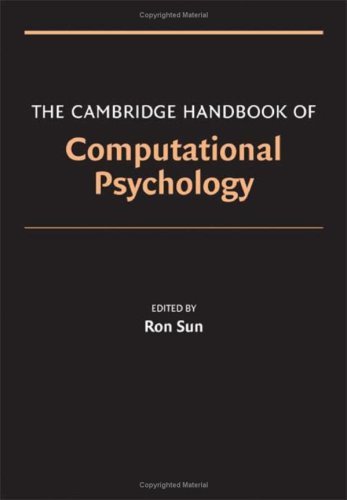Reviewed by
F.E.H. Nanda Wijermans
Dept of Innovation Management & Innovation, University of Groningen
 As intimidating the size of this handbook may be, it is a very welcome overview of the field of computational cognitive modelling. The Cambridge Handbook of Computational Psychology gives you what it promises. Not only does it succeed in being suitable for a newcomer in the field, it also hands the expert a fine quick-reference, as well as a source of ideas and an invitation for reflection.
As intimidating the size of this handbook may be, it is a very welcome overview of the field of computational cognitive modelling. The Cambridge Handbook of Computational Psychology gives you what it promises. Not only does it succeed in being suitable for a newcomer in the field, it also hands the expert a fine quick-reference, as well as a source of ideas and an invitation for reflection. This handbook manages to give the reader an idea of what is out there, which is a remarkable achievement given the size and complexity of the domain of (computational) cognitive modelling. The different paradigms are laid out (part II) by introducing the basics, the vision, the challenges, and even the main debates and critiques are presented. This is followed by a variety of concrete examples of research in cognitive modelling (part III). The last part of the book takes a more abstract perspective. The debates are set out in a nice historical perspective giving an overview on what led the field to the current state. In addition to that, this part also discusses the way researchers should proceed to reach their common goal of understanding cognitive phenomena (part IV). All ingredients to get a good sense of what is and what was going on in computational cognition are there.
Having said this, what can this handbook mean for JASSS readers? In my opinion this book is very relevant for us (= computational social science). The most important reason is that, though we have a different goal (understanding social vs. cognitive phenomena), we both share a large area in research. Unfortunately we rarely take notice of each other, though as pointed out in chapter 19, we are (partly) mutually dependent. Both fields could profit from each other resulting in more realistic models. This book is very helpful in bridging the two fields and helps social scientists getting to know the cognitive modelling domain. It does so by giving an overview, expanding our (cognitive) modelling options, and inducing awareness for the research hindrances.
An example of such a hindrance is the blindness for some problems, of which Sloman refers to as "ontological blindness" (chapter 26). In cognitive modelling there are "social problems" detectable. While reading the book it is hard for us not to notice how little attention is being paid to the social role in cognitive phenomena. This is exactly where our niches lie. However, it needs to be said that some authors raise awareness, and as Boden puts it in chapter 25: "cognitive science is not the science of cognition. At least, it is not the science of cognition alone ...". This is in my view also a take-home message for other domains as the exact same goes for us.
In conclusion, the book can provide you with the simplicity of an overview, but it can just as easily trigger in-depth discussions by making one aware of the underlying drive in doing research in either social or cognitive sciences. It's up to the reader to decide, and that is exactly what a handbook should do.
Return to Contents
of this issue
© Copyright Journal of Artificial Societies and Social Simulation, 2009